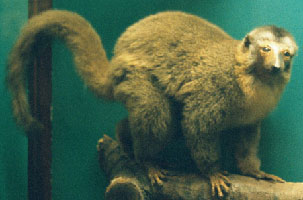The average body mass is around 2 kilograms. This species is sexually dimorphic, the males are gray-bodied having red fur along the side of body and face. The female’s body is a darker shade of gray having white fur along the side of body and face. This species, like all true lemurs has binocular vision, but not as developed as in other primates. The nose, like true lemurs, ends in a rhinarium used in olfactory communication.
RANGE:
They are found on the Comoro Islands and in the West of Madagascar.




